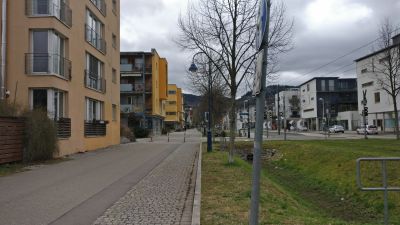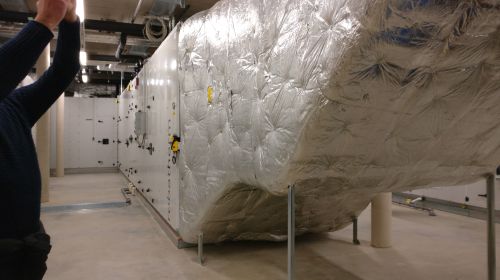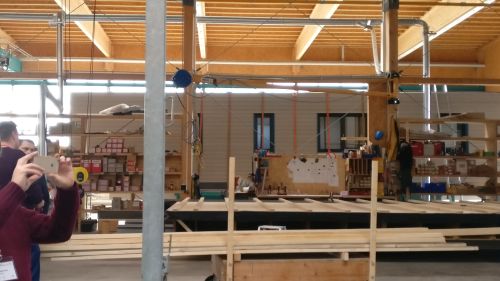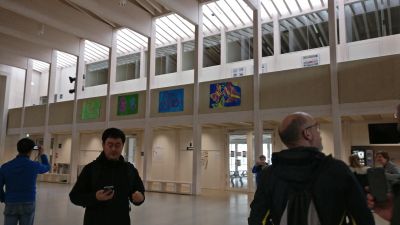This Month, Toby and Hannah travelled to Germany for what might be considered a holiday.
We travelled by Eurostar to Munich for the 22nd International Passivhaus Conference. Before the two-day conference we took advantage of a day of workshops, looking in depth in small groups at hygrothermal performance of high performance constructions in different climates; active cooling and dehumidification in Passivhauses, and energy efficient domestic hot water design.
Having done a lot of work around hygrothermal risk for UK and Irish projects, it was interesting to explore the implications of these issues in different climates. Passivhaus is gaining some traction in many parts of the world with very different climates to Central and Western Europe. Although the solutions are often very different, the basic principles are the same – focus on comfort, use the building fabric to minimise mechanical plant, and energy efficiency will fall into place. It turns out building in simply hot climates is fairly straight forward, but backwards to what we’re used to – vapour control on the outside please! Mixed climates that require both heating and cooling at different times of year are more challenging, and humid climates are tricky too. We love a good challenge, and to learn, so will be finding out more about this subject.
The hot water design workshop was more familiar; we have been implementing designs according to the AECB Water Standards for some time. Driving down hot water energy usage is critical for Passivhauses for several reasons. When the fabric is right and demand slow, the next most significant factor that designers can control is hot water energy. Although modest flow rates are an important part of this, it is not the only factor. Storage and distribution losses often outweigh the energy used ‘at the tap’, so good design can reduce energy consumption without enforcing three-minute 25 degree showers! Finally, we still use hot water in the summer, so minimising waste heat from DHW systems is a vital part of minimising overheating risk. While we use many of the ideas presented already, the session still inspired us to do even better, and to think about how we can follow these principles through to delivering finished buildings; in our experience it can be difficult to persuade installers that our systems will work. Perhaps a ‘Passivhaus for Plumbers’ course or book would help.
Hannah’s picks:
The use of cascade ventilation in apartments was a popular discussion point and has real potential to provide effective MVHR to large development projects. Particularly applicable in Urban areas where air quality is becoming a very important issue. Zehnder’s interesting analysis and research into mass flow rate balancing to ensure MVHR efficiency is maintained at lower external temperatures. Bertie Dixon’s concise and comprehensive guide to district heating design in Passivhaus multifamily residences.
During all sessions of the main conference, there were at least three parallel sessions, making it hard to pick and choose which speakers to listen to. Many sessions were in English and those that weren’t were live-translated. There was an enormous range of topics, from local, national and international policy in the plenary sessions, case studies from around the world, broad principles down to the fine details. Our personal favourite papers were retrofit case studies from China, External Airtightness, Passivhauses as heat batteries for balancing of renewable grids, and district heat design. Nick Grant was on usual fine form, issuing a call to arms in favour of real ‘value engineering’ – hint it’s not the same as cost cutting . . .
The exhibition included some innovative new products we will be considering for our future designs. All-in-one units incorporating MVHR, space heating and hot water seem to be increasingly popular, and although they are not for every project, they offer a neat, relatively compact solution for certain applications. Sadly, many of the products on display are currently more difficult to obtain in the UK but we hope these innovative companies will start to distribute more widely here.
The day after the conference we had the opportunity to tour a selection of Passivhauses, including the sales office and workshop of a timber frame company, a stunning new 1000-place school and an 11-unit ‘Baugruppe’ apartment block.

After the conference we made our way to Freiburg. It is in the sunny South West of the country near the French border. It has the black forest to the East, and the vineyards to the West – it turns out there is more to German wine than Blue Nun! Although we were aware of it’s eco-credentials (it’s a major centre of solar technology, and has some interesting city planning initiatives), we weren’t expecting to be quite so impressed. For the sustainable building nerd, the best bit is arguably the Vauban area. This zone was a French military base until the early 1990s, after which squatters and hippies moved in. In the UK, it’s easy to imagine this being sold off to a volume housing developer, but Freiburg took a very different approach. Such cases must go through a public consultation, and the city commissioned the organisation formed by the people inhabiting Vauban to run the process on their behalf. The result is a largely car-free suburb with a large central avenue with a glorious variety of multi-family apartment buildings and terrace housing, arranged around pedestrian cul-de-sacs and generous semi-wild green spaces. Many of the buildings were built using the Baugruppen approach, and there is a successful business in the community that now advises other people interested in the concept – including the building we visited near Munich. This is achieved partly though minimising car ownership; although there is multi-storey car parking on the edge of the zone, and you can get removals vans and emergency vehicles in, there are almost no parking spaces near the homes – on the other hand bike parking is abundant. It helps that Freiburg is a very cycleable city. It’s been observed by many people before but it’s amazing what the impact of de-prioritising cars has on a place. It was inspirational to see what housing can be, which is so much more than so many of the ubiquitous, ROI-optimal, concrete-tarmac-brick schemes we see in the UK.
We’re already thinking about our next visit, what papers we could submit to the conference, and how we can start our own Baugruppen project in the UK.





